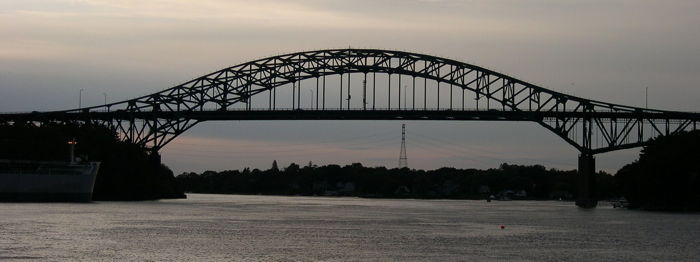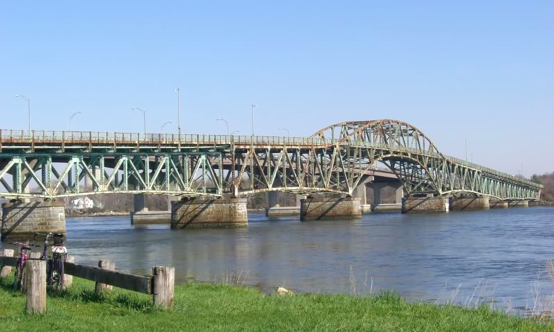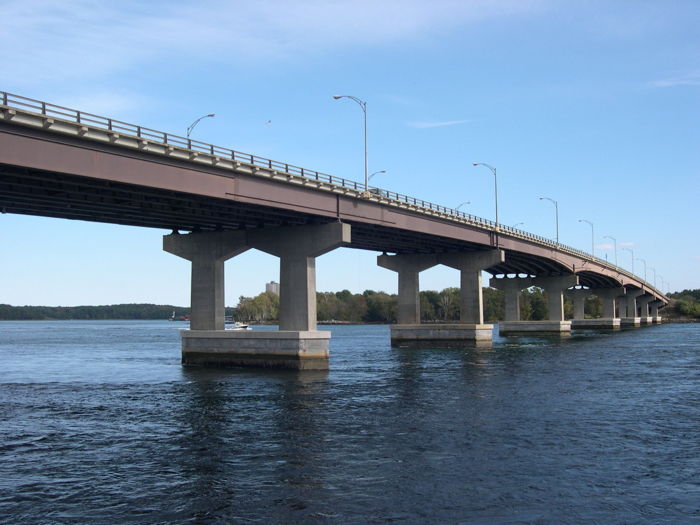Portsmouth NH Bridge Photos |
|
|
Memorial Bridge, Aug 2001
The Memorial Bridge is a through truss lift bridge that carries U.S. 1
across the Piscataqua River between Portsmouth, New Hampshire and Badger's
Island in Kittery, Maine USA.
The lift span can be fully opened to allow large commercial vessels to
pass. During summer, the lift section is partially elevated every half-hour
between 7AM and 7PM for smaller commercial and recreational boat traffic.
The bridge is the only one of the three Portsmouth Harbor bridges with
provisions for pedestrians and bicycles.
Constructed between 1920 and 1923, the bridge was the first without toll to
span the Piscataqua between Portsmouth and Kittery. The bridge was constructed
as a joint venture between the Maine, New Hampshire, and United States federal
governments. It was dedicated as a World War I memorial. Its plaque, above the
entrance to the first truss span on the Portsmouth side, reads:
Memorial to the Sailors and Soldiers of New Hampshire who participated in
the World War 1917-1919.
|

|
|
|
|
Memorial Bridge, Oct 2001
in fog
|

|
|
|
|
Memorial Bridge, July 2006
Many other photos available here
|

|
|
|
|
Sarah Mildred Long Bridge, Oct 2001
The Sarah Mildred Long Bridge is a lift bridge that carries the US 1 Bypass
over the Piscataqua River between Portsmouth, New Hampshire and Kittery, Maine.
The bridge is a double deck truss bridge, with the US 1 Bypass road deck above
and a railroad bed below.
The bridge features two separate movable spans. While the main lift span
and its towers are the obvious primary moving feature, the second moving span is
only apparent to water and rail traffic. On the north side of the bridge, the
first non-trussed section of rail bed lifts up and moves south as a retractable
bridge, coming to rest on top of the rail tracks inside the truss. This creates
a waterway large enough for most recreational boats to pass through without the
need for interruption of automobile traffic on the bridge.
Text continued below
|

|
|
|
|
Sarah Mildred Long Bridge, Oct 2001
Completed in 1940, the bridge is the second to carry motor vehicle traffic
between Maine and New Hampshire at Portsmouth, and replaced a river crossing
dating from 1822. The bridge was the direct result of the work of the
Maine-New Hampshire Interstate Bridge Authority, which had been formed in 1937.
The major goal of the bridge project was to relieve congestion in downtown
Portsmouth and Kittery, where US 1 crossed the river via the Memorial Bridge,
which had opened in 1923.
Text continued below
|

|
|
|
|
Sarah Mildred Long Bridge, Oct 2001
Memorial Bridge in background
From 1960 until 1972, the bridge, along with the US 1 Bypass north of the
Portsmouth Circle, filled a gap in Interstate 95, which had been designated
along both the New Hampshire Turnpike and the Maine Turnpike. Although most of
the Bypass is four lanes wide, the bridge itself originally had only a
three-lane roadbed, with traffic on the center lane switching direction
depending on load (the bridge has since been reduced to just two lanes). This,
combined with being a drawbridge, placed the bridge far below Interstate highway
standards. The turnpikes, and therefore I-95 in the two states, did not directly
connect until the opening of the Piscataqua River Bridge and the extensions of
I-95 leading to it in the early 1970s.
Text continued below
|

|
|
|
|
Sarah Mildred Long Bridge, July 2002
Wellington Kent cargo boat going downriver. Rt 95 bridge in background
The railroad track that runs across the bridge was originally part of the
Boston & Maine Railroad, and connected to South Berwick via an easement that is
now Rt. 236. The bridge replaced a railroad trestle that was located just
upriver. The trestle collapsed on September 10, 1939, sending the engine
and baggage car to the bottom of the river, where they remain. It had
been weakened when a caisson used in the construction of the new bridge dragged
its anchor cables, which pulled out several of the trestle's bents.
Currently, the tracks lead only to the Portsmouth Naval Shipyard in
Kittery, and are used for the transportation of nuclear materials.
|

|
|
|
|
Sarah Mildred Long Bridge, July 2010
Many other photos available here
|

|
|
|
|
Piscataqua River Bridge
The Piscataqua River Bridge, is a cantilevered through arch bridge that
crosses the Piscataqua River, connecting Portsmouth, New Hampshire with Kittery,
Maine. Carrying six lanes of Interstate 95, the bridge is the third modern span
and first fixed crossing of the Piscataqua between Portsmouth and Kittery. The
two older spans, the Memorial Bridge and the Sarah Mildred Long Bridge, are both
lift bridges, built to accommodate ship traffic along the Piscataqua. The high
arch design of the Piscataqua River Bridge eliminates the need for a movable
roadway.
Text continued below
|

|
|
|
|
Piscataqua River Bridge, behind the Long Bridge, May 2003
As part of the Interstate Highway System, Interstate 95 was routed along
the New Hampshire Turnpike, which had opened to traffic in 1950, and paralleled
US 1 through New Hampshire's seacoast from the Massachusetts border to the
Turnpike's end at the Portsmouth Circle. Between the Portsmouth Circle and
the beginning of the Maine Turnpike, there was a gap in I-95 that was filled by
the US 1 Bypass, crossing over the Sarah Mildred Long Bridge. Since the Long
bridge is a lift bridge with only a two lane roadway, it was far from meeting
Interstate Highway standards.
The decision was made to extend I-95 north from the New Hampshire Turnpike
at Portsmouth and south from the Maine Turnpike in Kittery, and join the roads
with an uninterrupted high speed span over the Piscataqua. Work on the bridge
was completed in 1971, and the I-95 extension to it in Maine was completed the
following year.
|

|
|
|
|
Piscataqua River Bridge, from upriver, Oct, 2006
|

|
|
|
|
View of other two bridges from middle of Memorial Bridge:
Sarah Mildred Long Bridge (aka Middle Bridge, Rt 1 Bypass),
and Piscataqua River Bridge (Rt 95). Sept 2011
Photo 56
|

|
|
|
|
General Sullivan Bridge
General Sullivan Bridge, which was built in 1935 and is still standing
though closed to traffic. The Little Bay Bridge is often referred to as the
"General Sullivan Bridge" as well, because it is at the same location as the
older bridge, and because of the eighteen-year period between the completion of
the first Little Bay span and the opening of the second, when both the old and
new bridges were in use.
The General Sullivan Bridge is a deck truss bridge, with a through truss
span to accommodate ship traffic, that formerly carried the roads that now
travel over the Little Bay Bridge. Completed in 1935, the bridge has been closed
to vehicle traffic since the opening of the second Little Bay span in 1984.
The bridge was named for John Sullivan, a Revolutionary War General,
Governor of New Hampshire, and delegate to the Continental Congress, who was
from nearby Somersworth.
Since being closed to vehicular traffic, the General Sullivan has been used
by pedestrians and cyclists, as the Little Bay Bridge does not have facilities
for foot traffic. The older bridge is also a popular fishing spot. Despite being
considered by some to be the second most historic bridge in New Hampshire (after
Portsmouth's Memorial Bridge), the future of the General Sullivan is uncertain.
|

|
|
|
|
General Sullivan Bridge, Oct 03
|

|
|
|
|
Little Bay Bridge
The Little Bay Bridge is a twin-span girder bridge that carries a
concurrency of U.S. Route 4, NH Route 16, and the Spaulding Turnpike across the
mouth of Little Bay, where it meets the Piscataqua River, between the city of
Dover and the town of Newington in New Hampshire.
The first span, which is now the southbound span, was opened in 1966. The
second span was opened in 1984.
The two spans were built to replace an older one, named the General
Sullivan Bridge, which was built in 1935 and is still standing though closed to
traffic.
|

|
|
|
|
Pierce Island Bridge
View from New Castle Ave., Memorial Bridge in
background, Pierce Island Bridge in front.
On August 9, 1923, Portsmouth purchased Pierce Island
for $11,000 and later built a wooden bridge to connect the
island to the mainland. The bridge was upgraded to steel in 1958.
Photo 261
|

|
|
|















